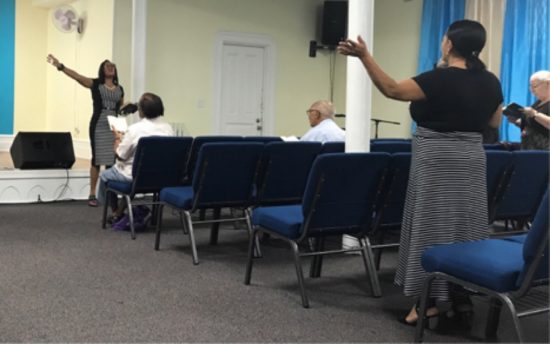
Churches team up to cope with declining revenues
Pale blue paint peels from the ceiling like dead skin. The church’s pipe organ broods in the balcony, its keys a row of yellowed teeth. Painted angels retreat into the beige walls like faded tattoos. Traces of pigeons pile the pulpit.
One floor below, a PowerPoint aids a twenty-first century sermon. Terse fluorescent lights shine on an amplified church band jamming to Christian contemporary music. On tap tonight is the story of Noah, a man who heeds a divine command to build an ark.
Like Noah, Graffiti 2 Community Ministries’ joyful pastor, Andrew Mann, is also in the business of holy construction. Pacing in sneakers, he urges his congregation to consider the big man upstairs. And for the literal one-flight up, Mann has begun a partnership with the building’s owners—another set of pastors—to eventually tackle the sanctuary’s renovation.
This is the church at 606 E. 141 St. The red brick edifice has changed pious hands multiple times since its founding in 1900. When Graffiti 2 moved in this July, the Baptist group joined Iglesia Evangelica Independiente—the property owner—and Iglesia Espiritu de Hermandad, a congregation that moved in this winter. As the trinity of churches shares the ground floor space on a rotating schedule, their arrangement allows each congregation to operate within budget and toward long-term goals.
Plus, they all get along.
“We’re one body in Christ. We see each other as brothers,” said a grinning Yimbert Remigio Javier, attending the Baptist service in a blue plaid shirt.
The 19-year-old’s parents, Victor Remigio and Olga Javier, have lead the Christian evangelical church that owns the building for 12 years, having spent the last two on major renovations to the ground floor. Bilingual Yimbert serves as a connector between his parents’ Spanish-speaking congregation at 10 a.m. and Graffiti 2, which worships in English at 6:30 p.m. During the week, the Lehman College physics student tutors at Mann’s after school program.
In charge of the sound board for his parents’ church, Yimbert also taught Mann how to use the system that boosts the faithful’s vocals. Yimbert paid that knowledge forward from Pastor Franklin Vargas, who bought the speakers for the space and taught the teen himself.
On Sundays at 2:30 p.m., Pastor Vargas’ Iglesia Espiritu de Hermandad service clears the aisle in front of the plexiglass pulpit for a Facebook Live taping. New York’s third “Spirit of Brotherhood” church, Vargas’ Spanish-speaking congregation has used the building since February after their former lodging on Willis Avenue was sold. The group contributes $1,500 a month from church collections toward heat and electricity.

A Hunts Point house of worship also shares its space. When faced with rising rent in the fall of 2014, Pastor Johnny Mercado was invited to relocate his Pentecostal Iglesia Cristiana Emmanuel congregation into Bright Temple African Methodist Episcopal Church at 812 Faile St. Pastor Karen Horry leads Bright Temple A.M.E.’s morning service. Mercado enters in the afternoon.
The three lead pastors at 606 E. 141st St. agree that their arrangement is harmonious, but it’s likely temporary. Vargas’ crew counts on a space of their own someday and currently manages investment property in Queens to raise funds. Graffiti 2 is also adjusting to its newcomer status.
“I’ve been going to church on Sunday mornings for 35 years, so now I don’t know what do to with myself,” joked Mann, about to start his evening service.
Graffiti 2 comprises a church and nonprofit under the same name, which offers afterschool mentoring, internships and part-time work for community members. The three churches’ staggered start times for each Sunday service allow for rotational use of the first floor pulpit, but during weekday afternoons, Graffiti 2 has full range of the space for its programs.
In exchange for operating under the Remigios’ roof, Graffiti 2 offers sweat equity. Remigio is grateful for help maintaining the old edifice; he used to lead services at the smaller parish house next door before he single-handedly renovated the ground floor space now used by all three groups. Mann said he seeks longevity for his congregation here after a shorter-term lease down the block terminated this summer.
With the help of volunteers through the Southern Baptist Convention, Graffiti 2 has already checked off some repairs. A new wheelchair accessible ramp not only squares with building code, but also affords Yimbert, who uses a wheelchair, easier access to the courtyard.
Graffiti 2 is halfway to a fundraising goal of $50,000, which prioritizes building a second bathroom and installing additional electricity. Then the Baptist group plans to remodel the basement with a kitchen. Volunteer foreman Ted Menster, who treks from North Carolina to help out, hopes the second floor transformation will start within two years.
“When we walked in there, we all felt something,” remembered Emily Medina, Graffiti 2 treasurer, on the first day she entered the abandoned nave. “We felt the spirit.”
“I walked in and my first thought was—this would make a gorgeous wedding!” gushed Kerri Johnson, director of Graffiti 2 Works.
David Pimentel did get married here. The 80-year-old treasurer of Iglesia Evangelica Independiente met his wife Elba outside of the church one warm Friday in the 60s—she wore a skirt and held a Bible. They got hitched in the stained glass sanctuary two years later. Elba passed on 20 years ago.
If the renovation works out, Pimentel could worship again in the church that witnessed so much of his life, pray again under the pale blue ceiling that imitated heaven.
“Oh,” he said, pausing on the phone. “That would be wonderful.”
